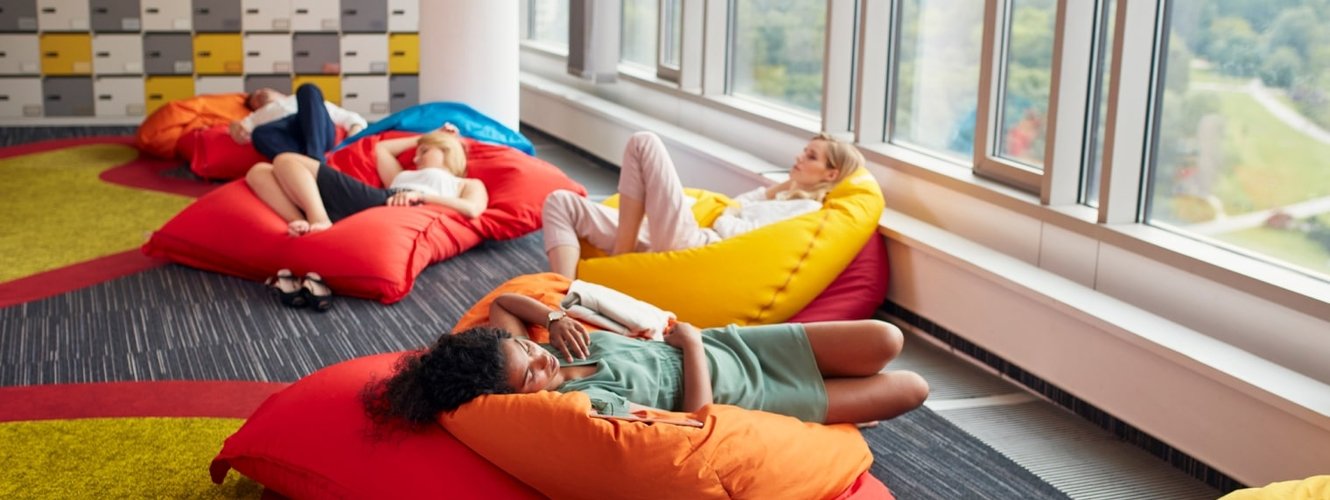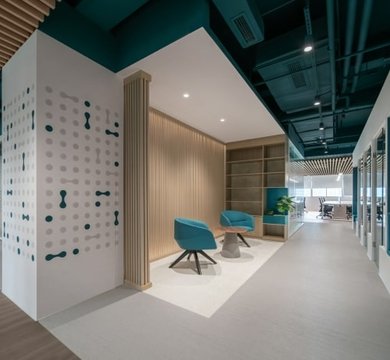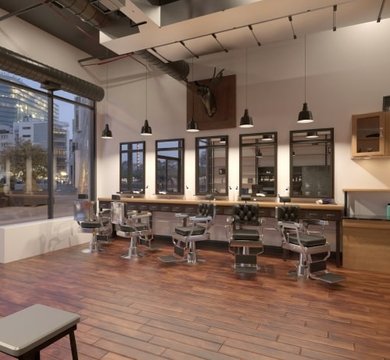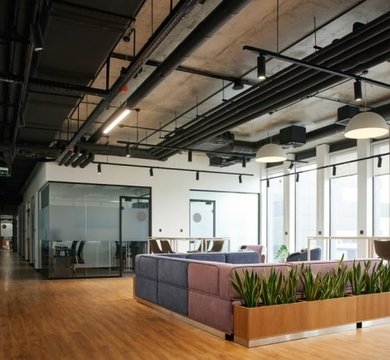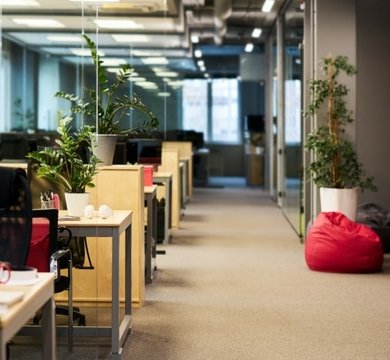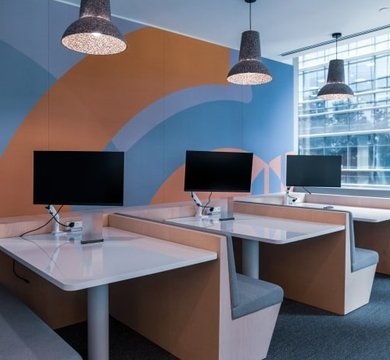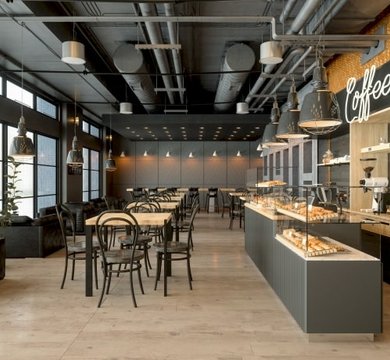The phrase ‘sleeping on the job’ has such negative connotations but power napping at work might be the revolutionary exercise your office needs. As commercial office designers and shop fitters, MPL Interiors always uses creative planning to address productivity and wellbeing in the workplace, and creating a place to peacefully snooze is on the agenda.
In this blog we explore whether a little office sleep is something you should promote among fellow professionals, and reveal how this can be achieved in a controlled manner as part of an office refurb in London or elsewhere in the UK.
The side effects of not sleeping well
Thousands of people are not getting enough sleep or their quality of slumber during the traditional nocturnal period is poor, affecting the output and value of their work. The reasons for not sleeping are multiple: there may be a medical reason (sleep apnea); a mental health issue (stress or anxiety); a neurological disorder (ADHD); environmental problems (anti-social neighbours) or a lifestyle reason (a new baby in the house).
At work, a lack of sleep can lead to poor concentration, reduced creativity, a lack of focus, poor judgement and decision making, greater risk taking and/or inappropriate behaviour, increased sickness and decreased communication. Not getting enough sleep is also linked to obesity, diabetes, heart disease and strokes.
Benefits of office power naps
If employees are not getting the recommended 7 to 9 hours sleep a night, your daytime problem may be how to control sleep in office settings. Power napping at work may feel like a lazy way to waste time but instead of it being a dismissible misdemeanour, snoozing should be encouraged.
Benefits of power napping at work
- Boosts brain function
- Increases memory storage
- Improves sharpness and alertness
- Reduces blood pressure
- Improves cognitive processes and motor skills
- Bolsters natural immunity and mood
Office sleep requires a culture shift
Unlike in Spain, where the siesta is part and parcel of daily life, there is still a stigma attached to daytime sleeping in the UK. When The Guardian ran an article on the perks of power napping at work, they revealed that sleeping at your desk in China is a constitutional right, while inemuri (“sleeping while present”) is a sign you’ve been working hard in Japan.
Closer to home, ice-cream manufacturer Ben & Jerry’s installed ‘snooze rooms’ in the workplace – a small space with a couch and blankets. With the benefits of an office sleep clear, perhaps our office design solutions can help you embrace 40 winks at work?
How long is the perfect office power nap?
The perfect length of a power nap at work is 20 minutes. This length of time ensures the person remains in a ‘near sleep state’, rather than a very deep slumber, waking up sharp and focused. There is such a thing as a ‘recovery nap’ too, which lasts about 40 minutes and does involve light sleep. Any nap longer than 40 minutes should be avoided.
Are office sleep pods the best way for employees to rest up
The Guardian article referenced earlier also contained the amazing statistic that 33% of Americans were napping daily, while another report revealed 25% of Brits were doing the same. The caveat? The figures pertained to people working remotely and therefore able to take a 20-minute siesta on their own sofa after lunch.
So, is it possible to achieve a good office sleep? The answer is yes and there are sleep pods specifically designed for the workplace. Tech companies have led the way in incorporating such items into the office – Facebook has a number of nap pods, while Google has ‘Shhhh zones’. There are even ‘soft nests’ for office use, which feature padding, drapes and multi-position seating, creating the perfect cocoon for jaded staff.
Providing sleep pods is an open, demonstrable way for employers to show staff they care about their wellbeing and performance at work. Alternatives to pods are quiet rooms with soft seating and soundproofing, or even a tucked away nook with a chair that faces away from the hub of the office.
Encouraging sleep is a remarkable form of trust that, unless policed, can be open to abuse. For some, an office sleep that’s just 10 minutes too long is enough to leave them drowsy, groggy and unfit for purpose. And if you hear snoring, you know a snooze has been taken a step too far.
How to control sleep in the office
Unless employees suffer with the rare medical condition narcolepsy, it is possible to stay awake at work. That said, if you catch colleagues ‘just resting their eyes’, it’s time to learn how to control sleep in office settings.
Permitting power napping at work is the first step, followed by providing a secure, comfortable place to retire to - workers will feel vulnerable as soon as they close their eyes. Controlling how much people sleep is the final step. Essential is a notice that reminds dozers to set an alarm for 20 minutes. Employers should also supply a sign in/sign out system so you know who has been using the facility and for how long. If the same names crop up time and time again, it may point to underlying health or wellbeing issues.
7 things to do for the best midday power nap
Research has revealed when employees are most likely to nod off at their desks. The people at Office Freedom commissioned a survey by OnePoll, and it pinpointed 13:27 as when office workers hit a slump and are at their least productive. Another crash in energy follows at 14:06.
We know the post-lunch slump is real, but resolvable, so how can you ensure your staff reap the rewards of power napping at work?
Insist people inform colleagues that they’re having an office sleep
This will manage the expectations of clients, customers and colleagues during the nap phase.
Ask for mobile phones to be muted
Essential for blocking out social media notifications and unwanted FaceTime calls from friends.
Provide an alarm clock
An alarm clock is vital to stop oversleeping. Alternatively, provide a ‘wake up’ service in the shape of a gentle knock on the door or the lifting of lights.
Install dimmable lights
Allowing each individual to alter the level of brightness in a room or nook will create optimum snoozing conditions.
Provide a sleep pod or reclining armchair
Add cushions and blankets for ultimate comfort, helping the person relax more quickly so they get the most from their nap.
Get the ambient temperature right
Make sure heat/comfort cooling can be adjusted by the napper with the installation of a wall-mounted or app-based thermostat control.
Block out daylight
Provide curtains, blinds or, at least, a personal supply of eye masks so the light level is lower than that of the main office.
Keep interruptions at bay
Install a ‘vacant/in use’ sign so the napper is not disturbed by eager colleagues or people hoping to use the room as a meeting space.
MPL Interiors can create a sleep zone in your workplace, either transforming an existing room, using partitions and soundproofing to create a new, dedicated space or specifying dedicated sleep pods. If you would like a free commercial office fit out or retail design appraisal, please contact MPL Interiors today.

